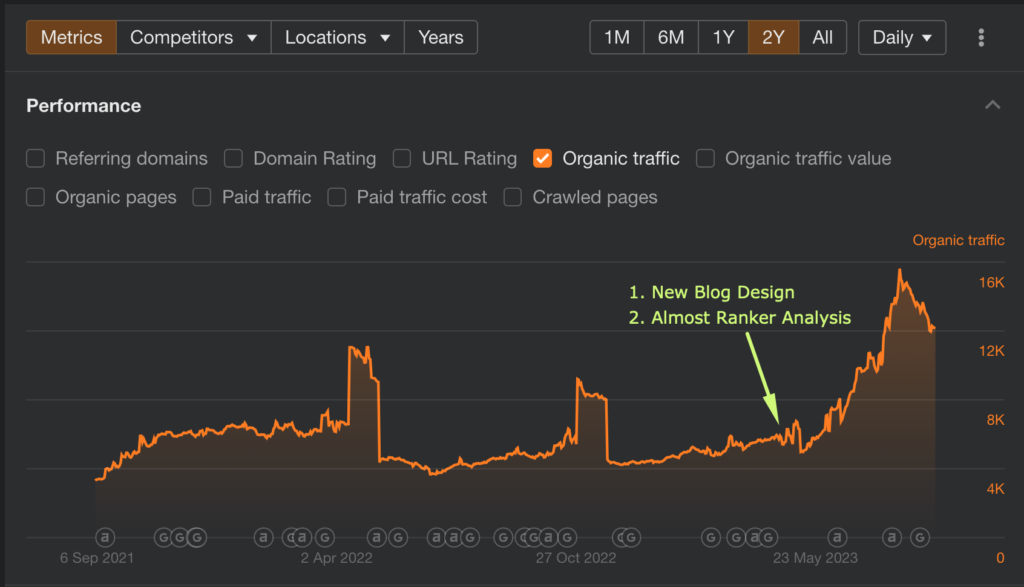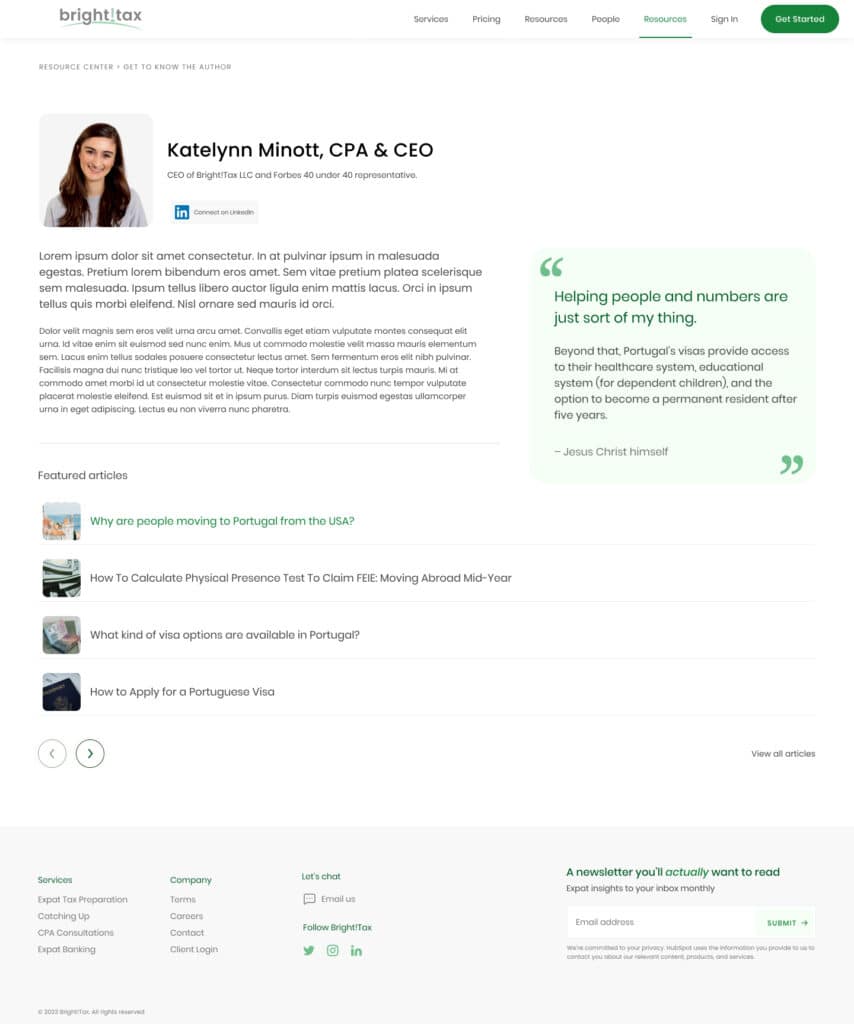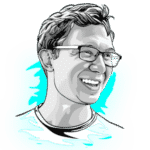
In this case study we’ll talk about the impact that a blog redesign + almost ranker analysis had on our recent content SEO project with https://brighttax.com
For B2B businesses a blog can often be the largest source of new non branded visits. We consider these visits the holy grail of SEO traffic, these users don’t know about your brand or product – but have discovered it organically through search for the first time.
A well optimized blog template can quickly become the most viewed content template on your domain, so we’ll discuss a few ways we optimize the BrightTax blog template for SEO + conversion.
BrightTax is an accounting firm that works with individuals and businesses that are based overseas, mostly targeting US based expats and digital nomads.
We’ll get straight to the point and discuss 2 main aspects of this project:
- Part 1: The design elements we used to affect SEO
- Part 2: How to run an “almost ranker” analysis
- Part 3: Blog Analytics ( coming soon ).
The players:
- AUQ SEO team
- AUQ Dev team
- BrightTax leadership
Goal:
- Increase organic traffic to the blog
- Improve conversion from the blog
Designing for SEO:
You can see the final product here, but we’ll break it down into design blocks, why we implement them and the SEO benefits of each.
Specifically we’ll cover:
- Author bylines & pages
- Table of contents
- FAQ sections
- Conversion elements
- Content highlights
- Bonus Gray Hat Tip: Random Footer Links
You can see the final product here:

Now we’ll dive into each individual aspect of the design and how it can impact usability & SEO.
Authorship = Relevance & Authority

One of the first things we recommend is a link to the author profile. Just having this alone is a sign of trust to most readers. Even more so if you can add qualifiers like M.D. / CPA / CFO etc… especially important for medical & financial content where Google ads extra scrutiny.
Google has published their own take on this subject by highlight E.E.A.T when rating websites. This essentially stands for:
E = Experience
E = Expertise
A = Authoritativeness
T = Trustworthiness
To understand how Google understand the links between trust and your authors – we can take a look at one of their patent covering “Author Vectors”. The TLDR here is Google can tie an Author’s reputation to content written by then – and do this across multiple domains.
This is where the importance of individual author pages comes in.

This page will serve as a link between your content -> your author -> their wider online persona.
There are a few crucial elements to include here:
- Schema Markup: include author schema markup on the article page which will then link to this page.
- List of Articles: a linkable list of articles written by this author on your domain. This helps Google identify their content, as well as make it easier for Google to index content that may be older.
- Online Profiles: in this case we’ve used their Linkedin profile, but you could also add links to any online content like ZocDoc profiles for doctors, Google Scholar for researchers and so on. This makes it easier for Google to draw the link between your Author’s and their general online persona.
- Bio + Photo: Some general information about the author, more so for readers and not spiders.
- Credentials Schema: this is a nice to have – consider adding a list of credentials and certifications to your author page and mark them up with this schema type to give Google a better understanding of your authors experience.
Note: WordPress site owners can use the native user page template and redesign it to include the proper elements. Other CMSs will need to create a unique page to house the bio and the articles for each author.
Table of Contents

A table of contents with jump links is a great tool for decreasing bounce rates on your blog. We recommend this block based on 2 principles:
- Users don’t read, they scan. Normal user behavior is to type a search query, get the best result and then scan the page until they find an answer to their query.
- Bounce rates are bad for SEO. It’s reasonable to assume that Google can track if a user clicked on a listing in their search results, did not get the answer they were looking for, went back to the same search results and either modified their search or clicked on a lower result. Since the first site did not provide the right result, Google will rank it lower for that search query.
So in this case we want to make sure that users can quickly find the answers they’re looking for, and give them a quick summary of the article with a table of contents.
We generally recommend making this table of contents and auto generated script that pulls in all the H2s in an article and adds it as a scrolling sidebar on desktop, or a fixed top block on mobile.
FAQ with schema markup

Until recently FAQs were a powerful tactic to get more real estate in the search results with an FAQ snippet appearing under your listing. Google has since weakened this practice ( it was 100% becoming overused ), however it’s still an effective way to include relevant phrases and topics into your article.
We still recommend incorporating FAQs into your content, mostly from the perspective of weaving in popular keywords and QA style phrasing to help rank for terms related to the main body of your article. Especially in cases where the author wasn’t able to weave them into the body.
Conversion Elements

Too often we’ve reviewed blog templates that fail to present users with meaningful conversions. After spending thousands on content, author training and SEO the blog will often be the single most viewed template for new non branded searches.
Make sure you find a way to capture this traffic and convert it into a customer, a free trial or at least an email lead. Consider these elements:
- Newsletter subscriptions: easy to set up, and manage with third party tools.
- Gated industry downloads: a stronger push for email collection – something as straighforward as “2023 industry stats” can get a lot of eyeballs. But make sure to match your gated content to the article topic.
- Consultations / Free Trials:
- Lower funnel articles: you’ve got their interest, now suggest a more sales focused article. For example “what is money laundering” to “5 saas tools for money laundering”.
**Tip: Don’t rely on sidebars for conversion elements, they will not be visible on mobile.
Related Articles

Seems like an obvious choice for most basic blog templates. However it can be under-utilized. In most cases this “related articles” section will default to a most recent articles organized by publish date.
We strongly recommend to utilize this section for clustering your related articles together. If you’re trying to rank for a certain industry keyword, make sure you link out to other articles that target the same topic.
There general strategy of creating “content clusters” around similar topics is well tested in SEO, for example – you may want to set up a hierarchy like so:
- Main Article: WordPress SEO Strategy
- Related Topic: WordPress SEO Audit
- Related Topic: WordPress Blog SEO
- Related Topic: WordPress Technical SEO
Of course the related article block isn’t the only way to build these clusters, we’ll also utilize body links with anchor text – but it’s still worth noting for an optimized approach. You don’t want all your “related articles” to link to the same 3 latest published blogs.
Content Highlights

Content highlights can be anything that breaks up the text of article, draws attention to certain elements but most importantly prevents it from looking like a wall of text. An average user will be intimidated by a 1,000 word article with no breaks, increasing the probability of a bounce.
So while these may seem like bells and whistles and nice-to-haves – they can still have an impact on SEO & conversion. Make sure you find a way to incorporate various breaks and design elements into your articles.
- Block Quotes: get a quote from an expert or from yourself!
- Memes: low hanging fruit that everyone likes.
- Charts: these will likely need to be designed and coded as HTML to be indexed.
- Banners / Conversions: we discussed these earlier.
Bonus Tip: Rotating Footer Article Links

This is a fun, but slightly hack-ish approach to getting your articles ranked and indexed. Especially useful for new sites that have a low crawl budget or low domain authority.
In these situations we like to write a script that randomizes links to blog articles from the footer. Every time the page loads it shows different links to different articles.
Why?
Well the idea is to force Google to crawl new pages every time it loads your site. Because footer links are weighted heavily since they’re on every page of your site, you’ll have an increased chance of getting your articles indexed and prioritized by crawlers.
